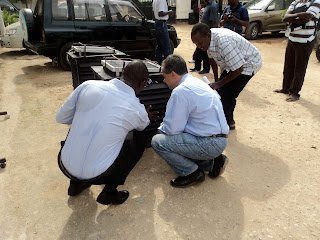The department head spoke to us first about the work of the OBS/GYNAE department. Some of the numbers shocked me. He told us that the hospital has about 32,000 deliveries each year, with a peak rate of 115 births in 24 hours. Those are huge numbers, for a hospital in any country.
The doctors then walked with us around 3 wards. I had never been to a maternity ward at a hospital at home, so it was a very eye-opening experience for me.
My initial reaction was surprise at just how many women there were. We walked through room after room of women in various stages of labour; the women filled each ward to capacity. In the first room, I was some compelling sights: a woman moaning on the ground in obstructed labour waiting for a cesarean section and a young girl, about my age (16 years old), who was 9 months pregnant.
Talking to doctors and nurses caring for a young girl in labour
One of the wards was specifically dedicated to the care of women with pre-eclampsia (a high blood pressure disease of pregnancy), and it was also completely filled. Finally we saw the 'high-dependency' room for women with complicated pregnancies. There were two patients who were having severe complications including something else I'd definitely seen before -- a woman getting a blood transfusion.
Listening to a nurse in the high dependency room discuss her work
To be honest, I was disturbed by some of what I saw. I think it was because I had not spent much time in hospitals. So problems like obstructed labour had never been visible to me. That changed here. Though I was unsettled, I realized that at least these women are in the right place to receive care, and I was able to hope that almost all of them would survive.




















